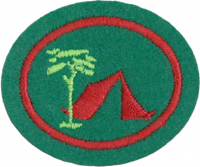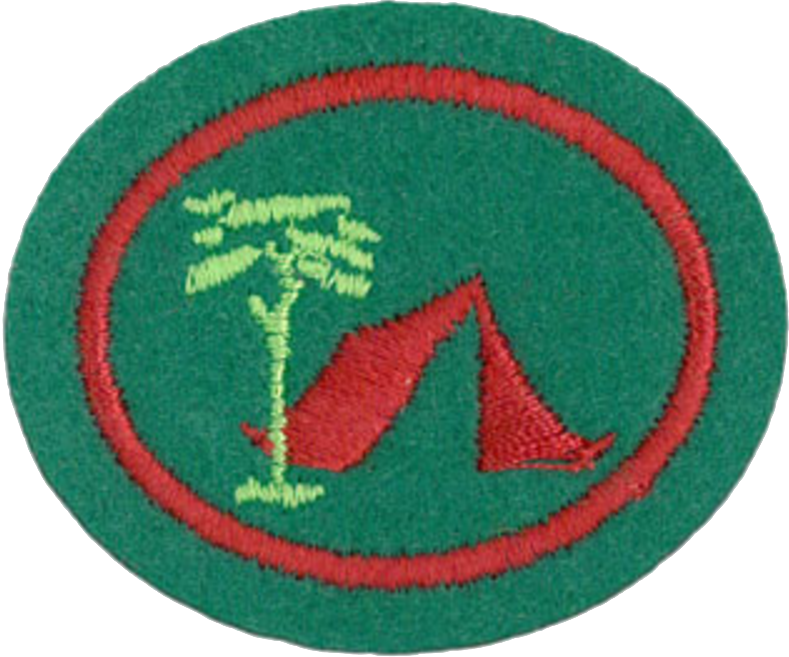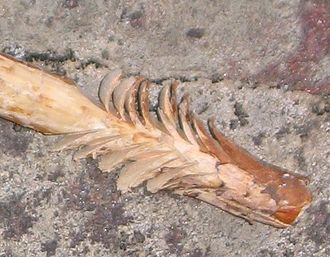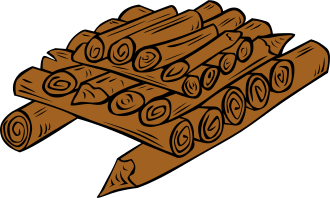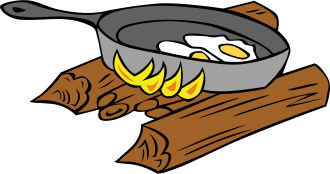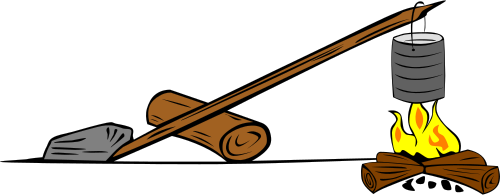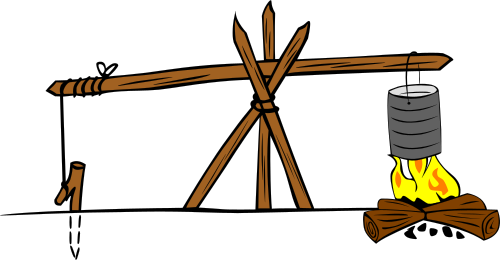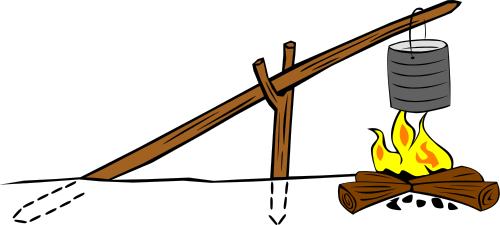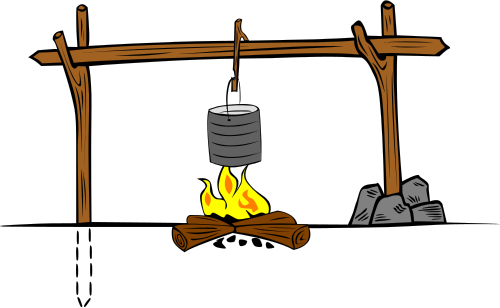Difference between revisions of "AY Honors/Camping Skills II/Answer Key"
m (- Category of AYHAB) |
|||
| (94 intermediate revisions by 13 users not shown) | |||
| Line 1: | Line 1: | ||
| − | {{ | + | {{HonorSubpage}} |
| − | = | + | <section begin="Body" /> |
| − | = | + | {{ansreq|page={{#titleparts:{{PAGENAME}}|2|1}}|num=1}} |
| − | + | <noinclude><translate><!--T:40--> | |
| − | + | </noinclude> | |
| − | + | <!-- 1. Be at least in the 6th grade. --> | |
| − | + | {{ay camping grade level|II|6}} | |
| − | |||
| − | |||
| − | |||
| − | |||
| − | |||
| − | |||
| − | |||
| − | |||
| − | |||
| − | |||
| − | |||
| − | |||
| − | |||
| − | |||
| − | {{ | ||
| − | + | <!--T:41--> | |
| − | + | <noinclude></translate></noinclude> | |
| − | == | + | {{CloseReq}} <!-- 1 --> |
| − | + | {{ansreq|page={{#titleparts:{{PAGENAME}}|2|1}}|num=2}} | |
| − | + | <noinclude><translate><!--T:42--> | |
| − | + | </noinclude> | |
| − | + | <!-- 2. Develop a personal philosophy of outdoor etiquette, such as courtesy to other campers and outdoor conservation. --> | |
| − | + | {{:AY Honors/Camping/Etiquette}} | |
| − | |||
| − | == | + | <!--T:43--> |
| + | <noinclude></translate></noinclude> | ||
| + | {{CloseReq}} <!-- 2 --> | ||
| + | {{ansreq|page={{#titleparts:{{PAGENAME}}|2|1}}|num=3}} | ||
| + | <noinclude><translate><!--T:44--> | ||
| + | </noinclude> | ||
| + | <!-- 3. Know and understand the following six W's for the selection of a good campsite: Wind, Water, Weather, Wild things, Wood, Willingness. --> | ||
| + | {{:AY Honors/Camping/Choosing a campsite}} | ||
| − | [[ | + | <!--T:45--> |
| + | <noinclude></translate></noinclude> | ||
| + | {{CloseReq}} <!-- 3 --> | ||
| + | {{ansreq|page={{#titleparts:{{PAGENAME}}|2|1}}|num=4}} | ||
| + | <noinclude><translate><!--T:46--> | ||
| + | </noinclude> | ||
| + | <!-- 4. Demonstrate your ability to protect the wilderness and your water source by proper personal hygiene and cooking sanitation. --> | ||
| + | Going on a camping trip does not absolve you from the need for hygiene and sanitation – it merely makes it a little less convenient. If you are camping on an established campground, use the toilet facilities provided. Otherwise, you will have to provide your own facilities. If you are camping with a small group, this can be as simple as digging a cat hole (no more than {{units|10 cm|4 inches}} deep, depositing your waste in the hole, and burying it again. A hole of this depth will be occupied by a myriad of bacterial life which will take care of the rest for you. If camping with a larger group, you will need to dig a latrine. Whether using cat holes or a latrine, make sure they are dug at least {{units|60 meters|200 feet}} from any water source. | ||
| + | |||
| + | <!--T:6--> | ||
| + | When cooking, be sure to clean your dishes and kitchen area immediately after use. Again, how you do this depends on the size of your group. When camping with a small group, wipe all dishes, pots, pans, and utensils as clean as you can with paper towels. Burn the paper towels. Then you can scrub the dishes out with clean sand and rinse them off. When camping with a large group, you will need to establish a dish washing area. Fill two tubs with water – use hot water if possible (and it almost always is). You can boil a small quantity of water and add it to a larger volume of cold water, and this will do nicely. One of these tubs will be for washing, the other for rinsing. You can optionally use a third tub for pre-rinsing, which will eliminate the need to wipe the dishes with a paper towel before washing. Add {{units|15 ml|one tablespoon}} of bleach to the rinse water. Wipe the dishes as clean as you can first (or pre-rinse them), ''then'' wash them in the first tub with dish soap. Then rinse. Wash the eating dishes first, followed by the cooking dishes. When finished, dispose of the "grey water" as directed by campground management (if on a campground). Otherwise, dispose of the grey water at least {{units|60 meters|200 feet}} from any water source. | ||
| + | |||
| + | <!--T:47--> | ||
| + | <noinclude></translate></noinclude> | ||
| + | {{CloseReq}} <!-- 4 --> | ||
| + | {{ansreq|page={{#titleparts:{{PAGENAME}}|2|1}}|num=5}} | ||
| + | <noinclude><translate><!--T:48--> | ||
| + | </noinclude> | ||
| + | <!-- 5. Participate in a weekend campout. --> | ||
| + | {{:AY Honors/Camping/Participate in a weekend campout}} | ||
| + | |||
| + | <!--T:49--> | ||
| + | <noinclude></translate></noinclude> | ||
| + | {{CloseReq}} <!-- 5 --> | ||
| + | {{ansreq|page={{#titleparts:{{PAGENAME}}|2|1}}|num=6}} | ||
| + | <noinclude><translate><!--T:50--> | ||
| + | </noinclude> | ||
| + | <!-- 6. Take part in a camp worship service to include one of the following: --> | ||
| + | <noinclude></translate></noinclude> | ||
| + | {{ansreq|page={{#titleparts:{{PAGENAME}}|2|1}}|num=6a}} | ||
| + | <noinclude><translate><!--T:51--> | ||
| + | </noinclude> | ||
| + | Bring a song book, or sing from memory. If your group has any musicians, encourage them to bring any portable instruments along (guitar, ukulele, recorder, harmonica, etc.). Even kazoos can be pressed into service. | ||
| + | <noinclude></translate></noinclude> | ||
| + | {{CloseReq}} <!-- 6a --> | ||
| + | {{ansreq|page={{#titleparts:{{PAGENAME}}|2|1}}|num=6b}} | ||
| + | <noinclude><translate><!--T:52--> | ||
| + | </noinclude> | ||
| + | Prepare ahead of time. You can download the Teacher's Lesson for the Junior's Sabbath School from http://powerpoints.adventist.org if desired. | ||
| + | <noinclude></translate></noinclude> | ||
| + | {{CloseReq}} <!-- 6b --> | ||
| + | {{ansreq|page={{#titleparts:{{PAGENAME}}|2|1}}|num=6c}} | ||
| + | <noinclude><translate><!--T:53--> | ||
| + | </noinclude> | ||
| + | Make sure the story has an aim. A story with a moral lesson is an essential part of a worship service. A story without an aim is entertainment. If you can coordinate the story with the lesson, all the better. | ||
| + | <noinclude></translate></noinclude> | ||
| + | {{CloseReq}} <!-- 6c --> | ||
| + | {{ansreq|page={{#titleparts:{{PAGENAME}}|2|1}}|num=6d}} | ||
| + | <noinclude><translate><!--T:54--> | ||
| + | </noinclude> | ||
| + | A "worship thought" can be a short sermon. One way to do this is to take a Bible story, figure out what the underlying message of that story is, and expound upon it. Read what Ellen White may have had to say about it (''The Desire of Ages'' follows the gospels), or consult a Bible Commentary set. If you do not have one, perhaps your church, school, or pastor does. | ||
| + | |||
| + | <!--T:55--> | ||
| + | <noinclude></translate></noinclude> | ||
| + | {{CloseReq}} <!-- 6d --> | ||
| + | {{CloseReq}} <!-- 6 --> | ||
| + | {{ansreq|page={{#titleparts:{{PAGENAME}}|2|1}}|num=7}} | ||
| + | <noinclude><translate><!--T:56--> | ||
| + | </noinclude> | ||
| + | <!-- 7. Know how to safely light and use a camp stove and lantern. --> | ||
| + | This will depend a lot on the type of stove or lantern you have. Most camp stoves and lanterns these days use small propane canisters. Make sure the canister is connected properly. Then light a stove lighter (these are long-stemmed butane lighters) near the burner of mantle. Only after the flame is going should you turn on the gas. If you turn on the gas before you light the flame, the gas can build up and you'll have a small (or large!) fireball to contend with. This can be very dangerous. If you have trouble, turn the gas off and let it dissipate before attempting again. Once the stove or lantern lights, adjust the flame or brightness as desired. | ||
| + | |||
| + | <!--T:57--> | ||
| + | <noinclude></translate></noinclude> | ||
| + | {{CloseReq}} <!-- 7 --> | ||
| + | {{ansreq|page={{#titleparts:{{PAGENAME}}|2|1}}|num=8}} | ||
| + | <noinclude><translate><!--T:58--> | ||
| + | </noinclude> | ||
| + | <!-- 8. Know safety rules and demonstrate your ability to properly cut firewood. Demonstrate how to break dead wood properly. --> | ||
| + | While firewood can be cut with an axe, it takes much less effort, and less wood goes to waste if it is cut with a saw. To do this, prop one end of the to-be cut log off the ground. This can be done by laying it on a rock, on another log, or on anything strong enough to hold its weight. The end of the log should protrude past the support, and the log should be sawn just past this point. If you try to cut a log between the support and the ground, the weight of the log cause the log to sag as it is cut, and this will pinch the saw blade. If you make the cut past the support, the weight of the log will open the saw cut making it easier to saw through. | ||
| + | |||
| + | <!--T:11--> | ||
| + | Dead wood can also be broken instead of sawn. This is often easier and quicker than sawing it, but care must be taken to do this properly, and it can only be done on smaller logs - up to {{units|7 cm|3 inches}} in diameter or so. To do this, again, the log is propped up on a support on one end, while the other end lies on the ground. Then the camper brings his foot down sharply about 12-18 inches (30-45 cm) from the support, between the support and the ground. Be careful to keep your footing while doing this, and watch that the ends of the log do not fly off. | ||
| + | |||
| + | <!--T:59--> | ||
| + | <noinclude></translate></noinclude> | ||
| + | {{CloseReq}} <!-- 8 --> | ||
| + | {{ansreq|page={{#titleparts:{{PAGENAME}}|2|1}}|num=9}} | ||
| + | <noinclude><translate></noinclude> | ||
| + | <!-- 9. Using fuzz sticks or shaved sticks, build and know the use of a council or criss cross fire and one type of cooking fire. Review firebuilding safety rules. --> | ||
| + | ===Fuzz sticks=== <!--T:60--> | ||
| + | {{:AY Honors/Camping/Fire/Fuzz sticks}} | ||
| + | ===Council fire=== | ||
| + | {{:AY Honors/Camping/Fire/Council}} | ||
| + | ===Hunter's fire=== | ||
| + | {{:AY Honors/Camping/Fire/Hunters}} | ||
| + | ===Fire safety=== | ||
| + | {{:AY Honors/Camping/Fire/Fire safety}} | ||
| + | |||
| + | <!--T:61--> | ||
| + | <noinclude></translate></noinclude> | ||
| + | {{CloseReq}} <!-- 9 --> | ||
| + | {{ansreq|page={{#titleparts:{{PAGENAME}}|2|1}}|num=10}} | ||
| + | <noinclude><translate><!--T:62--> | ||
| + | </noinclude> | ||
| + | <!-- 10. Explain two ways to keep camp food cool. --> | ||
| + | {{:AY Honors/Camping/Keeping food cool}} | ||
| + | |||
| + | <!--T:63--> | ||
| + | <noinclude></translate></noinclude> | ||
| + | {{CloseReq}} <!-- 10 --> | ||
| + | {{ansreq|page={{#titleparts:{{PAGENAME}}|2|1}}|num=11}} | ||
| + | <noinclude><translate><!--T:64--> | ||
| + | </noinclude> | ||
| + | <!-- 11. Build two different camp cranes. --> | ||
| + | |||
| + | <!--T:38--> | ||
| + | {| | ||
| + | |||
| + | <!--T:36--> | ||
| + | |- | ||
| + | |||
| + | <!--T:37--> | ||
| + | |[[Image:Camp Cooking Pot Hook.svg|frame|left|Pot Hanger]]A pot hanger or pot hook can be used to hang a cooking pot from a crane. This makes it easier to remove the pot without having to slide the hanging handle all the way to the end of the crane. This is particularly useful if you've built a crane that is supported on both sides of the fire. Carve a notch in a forked branch as shown to hang your cooking pot from a crane. | ||
| + | |- | ||
| + | |[[Image:Camp Cooking Pot Hook with Hand.svg|frame|left|Pot Hook]]A pot hook can also be used to place your cooking pot on the crane, or remove it from the crane while keeping your hand further from the heat. A notched branch could also be used. | ||
| + | |||
| + | <!--T:15--> | ||
| + | |- | ||
| + | |||
| + | <!--T:16--> | ||
| + | |[[Image:Camp Cooking Crane 01.svg|frame|left|Simple Crane]]This crane is the most simple of cranes. A long stick with a weight on the back propped over a log or rock will work fine. Feel free to use whatever is handy for propping up a crane. A large rock or two work as well as a log for this crane. | ||
| + | |||
| + | <!--T:17--> | ||
| + | |- | ||
| + | |||
| + | <!--T:18--> | ||
| + | |[[Image:Camp Cooking Crane 02.svg|frame|left|Adjustable Crane]]This crane allows for adjusting the heat of cooking by raising or lowering the cooking pot over the fire. By spiraling the piece of rope around the large stick, you can raise and lower the pot by twisting the stick to wind on more rope, or release more rope. The tripod could also be a forked branch driven into the ground. | ||
| + | |||
| + | <!--T:19--> | ||
| + | |- | ||
| + | |||
| + | <!--T:20--> | ||
| + | |[[Image:Camp Cooking Crane 03.svg|frame|left|Simple Crane]]A simple crane with a forked branch driven into the ground for support will work in areas where the soil is soft. Use a weight (Rock) to hold the crane down if the ground is too hard to drive the stick into for support. | ||
| + | |||
| + | <!--T:21--> | ||
| + | |- | ||
| + | |||
| + | <!--T:22--> | ||
| + | |[[Image:Camp Cooking Crane 04.svg|frame|left|Double Support Crane]]This crane supported on both sides of the fire is a popular choice and provides a stable crane. As seen on the right hand forked branch, use a small pile of rocks to hold the vertical supports where the ground is too hard to drive in a branch. | ||
| + | |||
| + | <!--T:23--> | ||
| + | |} | ||
| + | |||
| + | <!--T:24--> | ||
| + | The pictures here are worth many thousands of words. A simple crane propped on a forked stick will hold a cooking container over a fire. It is best to use green wood for any sticks that will be close to the fire, as green wood will resist catching fire better than a dry stick. Be sure to secure any vertical members so that the crane will not fall over when you hang the pot on it. Drive them deeply into the ground, or pin them in place with large rocks. Test the crane before committing your soup to it. If the pot topples, you will extinguish your fire ''and'' lose your soup in one sad incident. But at least you'll have a story to tell. | ||
| + | |||
| + | <!--T:25--> | ||
| + | <br style="clear:both"> | ||
| + | |||
| + | <!--T:65--> | ||
| + | <noinclude></translate></noinclude> | ||
| + | {{CloseReq}} <!-- 11 --> | ||
| + | {{ansreq|page={{#titleparts:{{PAGENAME}}|2|1}}|num=12}} | ||
| + | <noinclude><translate></noinclude> | ||
| + | <!-- 12. Prepare camp meals using boiling, frying, and baking. --> | ||
| + | ===Boiling=== <!--T:66--> | ||
| + | {{:AY Honors/Camping/Boiling}} | ||
| + | ===Frying=== | ||
| + | {{:AY Honors/Camping/Frying}} | ||
| + | ===Baking=== | ||
| + | {{:AY Honors/Camping/Baking}} | ||
| + | |||
| + | <!--T:67--> | ||
| + | <noinclude></translate></noinclude> | ||
| + | {{CloseReq}} <!-- 12 --> | ||
| + | {{ansreq|page={{#titleparts:{{PAGENAME}}|2|1}}|num=13}} | ||
| + | <noinclude><translate></noinclude> | ||
| + | <!-- 13. Demonstrate tent site selection. Properly pitch and strike a tent. What precautions should be taken when striking a wet tent? Properly clean, dry, and store a tent. --> | ||
| + | ===Tent site selection=== <!--T:68--> | ||
| + | Find an area that is large enough to pitch your tent and that is also flat. It is difficult to sleep on an incline. Avoid ridge tops as they will be windy and there is significant lightning danger there. Likewise avoid dry stream beds, especially in desert areas. Flash floods can be caused by rains many, many miles away. If camping near a river, camp above the high water line. The river may rise in the night. You can determine the high water line by observing trees on the river bank - they will have debris in the lower branches deposited there by flood waters. Camp on the lee side of a hill to avoid the wind. | ||
| + | |||
| + | <!--T:28--> | ||
| + | Carefully examine the space above your tent site, making sure there are no dead branches, icicles, coconuts, or anything else that could fall on the tent and cause harm. | ||
| + | |||
| + | ===Pitching and striking a tent=== <!--T:29--> | ||
| + | {{:AY Honors/Camping/Pitch and strike a tent}} | ||
| + | |||
| + | ===Cleaning a tent=== <!--T:30--> | ||
| + | Sweep the tent out before striking it. Remove muddy shoes before entering a tent, or take them off as soon as you enter the door. You can clean the floor in front of the door with paper towels. A stiff broom will also clean most debris from the walls, but you may need to use water and a mild detergent (such as dishwashing soap) to clean messes deposited by birds. | ||
| + | |||
| + | <!--T:69--> | ||
| + | <noinclude></translate></noinclude> | ||
| + | {{CloseReq}} <!-- 13 --> | ||
| + | {{ansreq|page={{#titleparts:{{PAGENAME}}|2|1}}|num=14}} | ||
| + | <noinclude><translate><!--T:70--> | ||
| + | </noinclude> | ||
| + | <!-- 14. Bedding: --> | ||
| + | <noinclude></translate></noinclude> | ||
| + | {{ansreq|page={{#titleparts:{{PAGENAME}}|2|1}}|num=14a}} | ||
| + | <noinclude><translate><!--T:71--> | ||
| + | </noinclude> | ||
| + | If your sleeping bag came with a stuff sack, all you have to do is stuff it in. It's really that simple. If it did not come with one, you can purchase one separately. Otherwise, you'll have to roll it up. That's a little more difficult, but not that hard. First check for the tie-strings. They are usually at the foot of the bag. Zip the sleeping bag closed and fold it in half lengthwise with the tie-strings down - one tie string will be located near the center of the bottom, and the other will be located near the edge. Then go to the end opposite the tie strings and start rolling, keeping it tight as you go. When you get to the end, draw the tie strings around the bag and tie them with a shoelace knot. | ||
| + | |||
| + | <!--T:72--> | ||
| + | <noinclude></translate></noinclude> | ||
| + | {{CloseReq}} <!-- 14a --> | ||
| + | {{ansreq|page={{#titleparts:{{PAGENAME}}|2|1}}|num=14b}} <!--T:32--> | ||
| + | <noinclude><translate><!--T:73--> | ||
| + | </noinclude> | ||
| + | The most important thing you can do to keep your sleeping bag dry is to keep it in the tent and keep the tent door closed. Take off your shoes when you enter the tent (or before going in) so you do not track water all over the place. Keep your sleeping bag on your sleeping pad, as this will raise it off the floor slightly so that any water that drips off wet clothing cannot reach it. | ||
| + | |||
| + | <!--T:74--> | ||
| + | <noinclude></translate></noinclude> | ||
| + | {{CloseReq}} <!-- 14b --> | ||
| + | {{ansreq|page={{#titleparts:{{PAGENAME}}|2|1}}|num=14c}} <!--T:33--> | ||
| + | <noinclude><translate><!--T:75--> | ||
| + | </noinclude> | ||
| + | Turn the sleeping bag inside-out, throw it over a clothesline, and beat it with a stick. Unzip it and let it air out completely. Do not put a sleeping bag in a washing machine unless the washing instructions on the bag specifically say that you can. A washing machine will crush the fibers inside, reducing the insulation and padding value. A bed roll can be shaken vigorously like a rug, and it can also be beaten with a stick after hanging it on a clothesline. | ||
| + | |||
| + | <!--T:76--> | ||
| + | <noinclude></translate></noinclude> | ||
| + | {{CloseReq}} <!-- 14c --> | ||
| + | {{CloseReq}} <!-- 14 --> | ||
| + | {{ansreq|page={{#titleparts:{{PAGENAME}}|2|1}}|num=Note|dispreq={{Localize|Note}}}} | ||
| + | <noinclude><translate><!--T:77--> | ||
| + | </noinclude> | ||
| + | <!-- Note: The tent color for Camping Skills #2 patch is red. --> | ||
| + | {{:AY Honors/Camping/Colors}} | ||
| + | |||
| + | <!--T:78--> | ||
| + | <noinclude></translate></noinclude> | ||
| + | {{CloseReq}} <!-- Note --> | ||
| + | <noinclude><translate></noinclude> | ||
| + | ==References== <!--T:35--> | ||
| + | <noinclude></translate></noinclude> | ||
| + | <section end="Body" /> | ||
| + | {{CloseHonorPage}} | ||
Latest revision as of 21:55, 13 July 2022
1
Camping Skills II has been designed so that it is within the capabilities of Pathfinders who are in grade 6 or higher.
2
Review and practice the Leave No Trace 7 Principles:
- Plan ahead and prepare.
- Travel and camp on durable surfaces.
- Dispose of waste properly.
- Leave what you find.
- Minimize campfire impacts (be careful with fire).
- Respect wildlife.
- Be considerate of other visitors.
© 1999 by the Leave No Trace Center for Outdoor Ethics
Be considerate of other campers. When purchasing tents, buy ones in muted colors that will blend in with the environment. If most of your camping is done at camp grounds frequented by others, blues, greens, and browns are preferred to reds and oranges. People go camping to escape the garishness of the city—leave that behind. However, if you camp in isolated places, bright and flashy colors make it easier to find your tent again if you leave it temporarily.
More importantly, when traveling in areas that allow hunting, wear bright colors such as orange to alert other's to your presence. An orange vest or hat is common.
Be mindful of the noise level made in your camp. Don't be a nuisance. If camping in the wilderness, be sure to make your camp out of sight of the trail. Most National Forests have guidelines for where you can camp in relation to the trail. Find out what those guidelines are and follow them.
Do not enter anyone else's camp site without their permission, especially when traveling to or from your campsite to other places on the campground. It is very rude to cut through another camp. Use the road or trail, even if it will take longer.
Leave the area cleaner than you found it If you are leading a group of youngsters on a campout, have a contest before you pile back in your cars to go home: see who can collect the most litter (define "most" first though - it can mean by volume, by weight, or by item count). Offer a prize to the one who collects the most (such as getting to choose which seat he or she will sit in on the trip home).
3
To help remember the things that are important to camp site selection, remember the six W’s:
- Wind- Find areas that are protected from the wind. This requires knowing or guessing at the normal wind direction (hint look at the direction trees are leaning and the current wind direction)
- Water- Fresh water should be available for drinking, beware of drainage areas, flooding and other water related hazards. Marshy areas can have a high mosquito population that can make camping miserable.
- Weather- Knowledge of the weather patterns of an area can help you decide the best location for the camp site.
- Wild things- Beware of signs of large mammals such as bear, wolves, and mountain lions. Also watch out for the small wild things such as snakes, spiders, ticks, biting flies and mosquitoes.
- Wood- Adequate wood should be available for a campfire, and no dead wood above sleeping area. Survey the trees to make sure that they will not fall on you in strong winds.
- Willingness- Make sure the owner of the property is willing for you to camp on it. Make sure you have the proper permits for camping areas.
4
Going on a camping trip does not absolve you from the need for hygiene and sanitation – it merely makes it a little less convenient. If you are camping on an established campground, use the toilet facilities provided. Otherwise, you will have to provide your own facilities. If you are camping with a small group, this can be as simple as digging a cat hole (no more than 10 cm![]() deep, depositing your waste in the hole, and burying it again. A hole of this depth will be occupied by a myriad of bacterial life which will take care of the rest for you. If camping with a larger group, you will need to dig a latrine. Whether using cat holes or a latrine, make sure they are dug at least 60 meters
deep, depositing your waste in the hole, and burying it again. A hole of this depth will be occupied by a myriad of bacterial life which will take care of the rest for you. If camping with a larger group, you will need to dig a latrine. Whether using cat holes or a latrine, make sure they are dug at least 60 meters![]() from any water source.
from any water source.
When cooking, be sure to clean your dishes and kitchen area immediately after use. Again, how you do this depends on the size of your group. When camping with a small group, wipe all dishes, pots, pans, and utensils as clean as you can with paper towels. Burn the paper towels. Then you can scrub the dishes out with clean sand and rinse them off. When camping with a large group, you will need to establish a dish washing area. Fill two tubs with water – use hot water if possible (and it almost always is). You can boil a small quantity of water and add it to a larger volume of cold water, and this will do nicely. One of these tubs will be for washing, the other for rinsing. You can optionally use a third tub for pre-rinsing, which will eliminate the need to wipe the dishes with a paper towel before washing. Add 15 ml![]() of bleach to the rinse water. Wipe the dishes as clean as you can first (or pre-rinse them), then wash them in the first tub with dish soap. Then rinse. Wash the eating dishes first, followed by the cooking dishes. When finished, dispose of the "grey water" as directed by campground management (if on a campground). Otherwise, dispose of the grey water at least 60 meters
of bleach to the rinse water. Wipe the dishes as clean as you can first (or pre-rinse them), then wash them in the first tub with dish soap. Then rinse. Wash the eating dishes first, followed by the cooking dishes. When finished, dispose of the "grey water" as directed by campground management (if on a campground). Otherwise, dispose of the grey water at least 60 meters![]() from any water source.
from any water source.
5
Weekend campout are a lot of fun, especially if the campers have some knowledge of camping! Once every five years, Seventh-day Adventist Divisions hold a division-wide camporee, where people from all over their division attend. Many clubs from outside the division also attend. In 2009, the North American Division held a camporee in Oshkosh Wisconsin, and it was attended by 33,000 Pathfinders! The NAD also held camporees in Oshkosh in 1999 and in 2004, and at other locations prior to that.
Within the Divisions are Unions, and many of them hold camporees every five years as well. Union Camporees are held between Division Camporees. Unions are groups of local Conferences. Many Pathfinder clubs attend Conference Camporees every year - and some conferences have camporees twice a year (once in the fall, and again in the spring). In addition to these camporees, some clubs go camping by themselves as a club. This is a special bonding time for members of the local Pathfinder club. Of course, Pathfinders also like to camp with their friends and families, and those trips can also be used to meet this requirement. Remember, the more you know about camping, the more fun it is!
6
6a
Bring a song book, or sing from memory. If your group has any musicians, encourage them to bring any portable instruments along (guitar, ukulele, recorder, harmonica, etc.). Even kazoos can be pressed into service.
6b
Prepare ahead of time. You can download the Teacher's Lesson for the Junior's Sabbath School from http://powerpoints.adventist.org if desired.
6c
Make sure the story has an aim. A story with a moral lesson is an essential part of a worship service. A story without an aim is entertainment. If you can coordinate the story with the lesson, all the better.
6d
A "worship thought" can be a short sermon. One way to do this is to take a Bible story, figure out what the underlying message of that story is, and expound upon it. Read what Ellen White may have had to say about it (The Desire of Ages follows the gospels), or consult a Bible Commentary set. If you do not have one, perhaps your church, school, or pastor does.
7
This will depend a lot on the type of stove or lantern you have. Most camp stoves and lanterns these days use small propane canisters. Make sure the canister is connected properly. Then light a stove lighter (these are long-stemmed butane lighters) near the burner of mantle. Only after the flame is going should you turn on the gas. If you turn on the gas before you light the flame, the gas can build up and you'll have a small (or large!) fireball to contend with. This can be very dangerous. If you have trouble, turn the gas off and let it dissipate before attempting again. Once the stove or lantern lights, adjust the flame or brightness as desired.
8
While firewood can be cut with an axe, it takes much less effort, and less wood goes to waste if it is cut with a saw. To do this, prop one end of the to-be cut log off the ground. This can be done by laying it on a rock, on another log, or on anything strong enough to hold its weight. The end of the log should protrude past the support, and the log should be sawn just past this point. If you try to cut a log between the support and the ground, the weight of the log cause the log to sag as it is cut, and this will pinch the saw blade. If you make the cut past the support, the weight of the log will open the saw cut making it easier to saw through.
Dead wood can also be broken instead of sawn. This is often easier and quicker than sawing it, but care must be taken to do this properly, and it can only be done on smaller logs - up to 7 cm![]() in diameter or so. To do this, again, the log is propped up on a support on one end, while the other end lies on the ground. Then the camper brings his foot down sharply about 12-18 inches (30-45 cm) from the support, between the support and the ground. Be careful to keep your footing while doing this, and watch that the ends of the log do not fly off.
in diameter or so. To do this, again, the log is propped up on a support on one end, while the other end lies on the ground. Then the camper brings his foot down sharply about 12-18 inches (30-45 cm) from the support, between the support and the ground. Be careful to keep your footing while doing this, and watch that the ends of the log do not fly off.
9
Fuzz sticks
A fuzz stick is a small piece of wood which has had slices cut in the sides to create small shavings. Ideally, the shavings should remain attached to the stick, but if they are accidentally removed, they can still be used. Because the shavings are thin, they are easy to ignite. Because they are attached, they in turn ignite the larger host stick.
To make a fuzz stick safely, choose a piece of dry wood, preferably a dry, dead stick from an evergreen tree. The stick should be about the size of a pencil, or perhaps a little larger. Place one end of the stick against a firm surface, such as a log or a rock, hold the upper end with your left hand, and hold the knife in the right. Carefully slice into the stick with a downward, diagonal motion, maintaining even pressure. Stop before the knife reaches the center of the stick. Take another slice a little higher up, and repeat until the stick is covered with the slices of "fuzz." Turn the stick over and make more shavings on the other side. This is far easier to do with a sharp knife and with a soft wood such a pine, fir, spruce or hemlock. Be sure that you are always slicing away from your fingers. Think at all times about where the knife blade will go if the shaving breaks off, or the knife slips. Make sure that your hand, foot, leg, companions, etc. are not in the path!
Make several fuzz sticks and use them as the first layer of kindling, positioning them atop the tinder. In some cases, the fuzz sticks themselves can be used as tinder.
Council fire
The council fire was used by Native Americans during their meetings (or councils). It is very much like the log cabin fire except that more than two logs are laid on each layer. Be careful not to lay the logs too close to one another. Leave gaps of at least one inch (2.5 cm) between each log to allow air to circulate. Like the log cabin fire, the council fire is very stable, and it falls into itself as it burns, remaining within the fire ring. Unlike the log cabin fire, the council fire lights easily as the main fuel is located directly above the kindling and tinder where convection will carry the flames. This fire is hot and will make a nice bed of coals for cooking. It also uses a lot of fuel. This fire is sometimes called a pyramid fire as well.
Hunter's fire
The hunter's fire is a cooking fire. The logs on top are spaced close enough together such that a pot, pan, or Dutch oven can be placed on them. Try to lay it as level as possible.
Fire safety
- Locate the fire in a safe place. It should be clear for 10 feet (3 meters) all around.
- Do not light a fire beneath overhanging branches or tents, shelters etc.
- Do not use accelerants, such as lighter fluid, gasoline, kerosene, etc. Learn to light a fire without these.
- Put the fire out completely before leaving it. If it's too hot to put your hands in the ashes, it's not sufficiently out. Douse it down with water, turn the coals with a shovel, and be sure to extinguish every coal and ember.
- Do not build a fire on top of flammable material such as grass or leaves.
- Cut away the sod (keep it moist so it stays alive, and replace it before your leave), and clear away the duff and litter.
- Keep fire extinguishing supplies handy and near the fire. A bucket of water or sand, or a fire extinguisher are recommended.
- Do not remove burning sticks from a fire.
- Watch for embers that escape the fire pit and extinguish them immediately.
- Wear proper footwear around a fire.
- Be aware that paper, cardboard, and leaves create floating embers that rise out of the fire pit and may land dozens of yards away.
- Do not light a fire when conditions are adverse (high winds, or drought conditions) or when fires are prohibited by law.
10
The most effective way to keep camp food cool on a campout is by storing it in a cooler with ice. Use blocks of ice rather than ice cubes or crushed ice, as it will remain frozen far longer. Solid blocks of ice should easily last for three days. You can buy it at a store or make it ahead of time by freezing water in plastic gallon or half-gallon jugs. You do not need to remove the ice from the jugs. To extend the life of the ice, make sure the cooler's lid is closed all the way and tight-fitting, and do not leave it open any longer than necessary.
One way to keep food cool without ice while on a camping trip is to place the food in a water-proof container, place that in a mesh bag and secure it in a stream or brook. Another way is to put the food in a bag, cover it with several layers of burlap, wet the burlap, and suspend it from a tree branch. As the water evaporates from the burlap, it will cool the food. You have to re-wet the bag occasionally.
11
| A pot hanger or pot hook can be used to hang a cooking pot from a crane. This makes it easier to remove the pot without having to slide the hanging handle all the way to the end of the crane. This is particularly useful if you've built a crane that is supported on both sides of the fire. Carve a notch in a forked branch as shown to hang your cooking pot from a crane. |
| A pot hook can also be used to place your cooking pot on the crane, or remove it from the crane while keeping your hand further from the heat. A notched branch could also be used. |
| This crane is the most simple of cranes. A long stick with a weight on the back propped over a log or rock will work fine. Feel free to use whatever is handy for propping up a crane. A large rock or two work as well as a log for this crane. |
| This crane allows for adjusting the heat of cooking by raising or lowering the cooking pot over the fire. By spiraling the piece of rope around the large stick, you can raise and lower the pot by twisting the stick to wind on more rope, or release more rope. The tripod could also be a forked branch driven into the ground. |
| A simple crane with a forked branch driven into the ground for support will work in areas where the soil is soft. Use a weight (Rock) to hold the crane down if the ground is too hard to drive the stick into for support. |
| This crane supported on both sides of the fire is a popular choice and provides a stable crane. As seen on the right hand forked branch, use a small pile of rocks to hold the vertical supports where the ground is too hard to drive in a branch. |
The pictures here are worth many thousands of words. A simple crane propped on a forked stick will hold a cooking container over a fire. It is best to use green wood for any sticks that will be close to the fire, as green wood will resist catching fire better than a dry stick. Be sure to secure any vertical members so that the crane will not fall over when you hang the pot on it. Drive them deeply into the ground, or pin them in place with large rocks. Test the crane before committing your soup to it. If the pot topples, you will extinguish your fire and lose your soup in one sad incident. But at least you'll have a story to tell.
12
Boiling
Camping foods that are prepared by boiling include:
- Pasta (spaghetti, macaroni, etc.)
- Oatmeal
- Boiled eggs
- Cooked vegetables (carrots, green beans, corn, etc.)
An easy way to make corn on the cob is by putting the husked ears in a clean cooler, adding enough boiling water to cover it, and then closing the cooler. Let it sit for five or ten minutes. The corn will remain hot enough to prevent bacterial growth for half a day or more.
Frying
Foods that are prepared by frying include
- Pancakes
- Scrambled or fried eggs
- French toast
- Vegetarian sausages
- Veggie burgers
- Grilled cheese sandwiches
Baking
Foods that are prepared for baking on a campout include:
- Bread on a stick
- Biscuits
- Cobbler (see the Dutch Oven Cooking honor for more ideas)
- Baked potatoes
- Corn on the cob
- Veggie burgers
Baked potatoes, corn on the cob, and veggie burgers can all be baked by wrapping them in aluminum foil and covering them with hot coals. Veggie burgers can have onions, carrots, and thin potato slices added to them and cooked in the same package. Delicious!
13
Tent site selection
Find an area that is large enough to pitch your tent and that is also flat. It is difficult to sleep on an incline. Avoid ridge tops as they will be windy and there is significant lightning danger there. Likewise avoid dry stream beds, especially in desert areas. Flash floods can be caused by rains many, many miles away. If camping near a river, camp above the high water line. The river may rise in the night. You can determine the high water line by observing trees on the river bank - they will have debris in the lower branches deposited there by flood waters. Camp on the lee side of a hill to avoid the wind.
Carefully examine the space above your tent site, making sure there are no dead branches, icicles, coconuts, or anything else that could fall on the tent and cause harm.
Pitching and striking a tent
The details vary for every type of tent there is, so we provide only general tips here. First, carefully read the instructions that came with your tent. If it's a new tent, keep the instructions. You might be surprised how easy it is to forget which pole goes where.
First, unpack the tent and spread it on the ground. Some people like to put the ground cloth under the tent, and others like to put it inside. If you're going to put it beneath the tent, spread it out first. Before doing anything else, lie down on the ground cloth and test each sleeping area. If you feel a lump get rid of it now.
Then lay out the tent's canopy (that is, the cloth part that is not the fly). Find the door and orient it where you want it. Then stake it down. This will prevent the wind from blowing it away while you are trying to raise it. Slide the poles into the tubes, but do not raise the tent until the main poles (usually two of them) are all in place. Then raise them together. There are usually aluminum "hooks" located at the stake-down straps and shaped somewhat like a question mark. They are usually a couple of inches long, and are there to slip the pole ends over. Once all the pole are in place, throw the fly over the tent, being careful that the up side is up and the front side is to the front.
Flies often have elastic ropes that attach to plastic clips near the pole anchors, and they also generally have a rope at the four major corners. These should be anchored such that the fly is held off the tent's canopy, usually by staking them down or tying them to a tree. In the "olden days" a taut line hitch would be used to tighten these ropes, but these days the ropes are fitted with a three-hole plastic strap. The end of the rope passes through the bottom-most hole and is tied off with a stopper knot. From there, the rope goes to the anchor (tree, stake, etc.), and passes through the middle hole, and then again through the top hole. The plastic strap can then be slid up and down the rope to adjust the tension. Do not over-tension these ropes - they should have some give so that the tent can move a little with the wind. If they are too tight, the wind will rip the stakes from the ground or topple the tent.
If possible, do not strike the tent until it has dried. If you can, wait until the morning dew has evaporated. This is, of course, not always possible - it could be pouring rain when it's time to go, so you'll have to strike a wet tent. If your tent is wet when you strike it, you will need to set it up to let it dry as soon as you get back. Do not store a wet tent. It will be quickly ruined with mold and mildew.
To strike the tent first inspect the inside, being sure that everything has been removed. Check the loops in the ceiling (coat hangers tend to hide there) and the "stuff" bags on the walls (glasses and keys tend to hide there). Then sweep the tent. Once everything has been removed, pull off the fly, and stow it inside the tent (spread it out as flat as you can). If you stand next to the tent's door, you can pull the fly off the canopy and stuff it directly inside without it ever hitting the outside ground (and thus picking up dirt, leaves, and moisture). Stowing the fly inside also avoids the sad problem of cramming the canopy and poles into the tent's duffel, and then noticing the that the fly still needs to get crammed in there too. It's one less thing to roll up.
Then let down the poles. Carefully remove the poles from the canopy and fold them up. If the tent poles are sectional tubes with a long piece of elastic running through them all, it is better to push the poles out of the canopy rather than trying to pull them through. Pulling on them merely separates the sections and may break the elastic. Broken elastic will have to be repaired before the tent can be pitched again, because the elastic actually holds the poles together.
Once the poles have been stowed, remove the stakes and carefully fold the tent. Put everything back into the bag it came in.
Cleaning a tent
Sweep the tent out before striking it. Remove muddy shoes before entering a tent, or take them off as soon as you enter the door. You can clean the floor in front of the door with paper towels. A stiff broom will also clean most debris from the walls, but you may need to use water and a mild detergent (such as dishwashing soap) to clean messes deposited by birds.
14
14a
If your sleeping bag came with a stuff sack, all you have to do is stuff it in. It's really that simple. If it did not come with one, you can purchase one separately. Otherwise, you'll have to roll it up. That's a little more difficult, but not that hard. First check for the tie-strings. They are usually at the foot of the bag. Zip the sleeping bag closed and fold it in half lengthwise with the tie-strings down - one tie string will be located near the center of the bottom, and the other will be located near the edge. Then go to the end opposite the tie strings and start rolling, keeping it tight as you go. When you get to the end, draw the tie strings around the bag and tie them with a shoelace knot.
14b
The most important thing you can do to keep your sleeping bag dry is to keep it in the tent and keep the tent door closed. Take off your shoes when you enter the tent (or before going in) so you do not track water all over the place. Keep your sleeping bag on your sleeping pad, as this will raise it off the floor slightly so that any water that drips off wet clothing cannot reach it.
14c
Turn the sleeping bag inside-out, throw it over a clothesline, and beat it with a stick. Unzip it and let it air out completely. Do not put a sleeping bag in a washing machine unless the washing instructions on the bag specifically say that you can. A washing machine will crush the fibers inside, reducing the insulation and padding value. A bed roll can be shaken vigorously like a rug, and it can also be beaten with a stick after hanging it on a clothesline.
Note
| Color | AY Class | Honor |
| Blue | Friend | Camping Skills I |
|---|---|---|
| Red | Companion | Camping Skills II |
| Green | Explorer | Camping Skills III |
| Silver | Ranger | Camping Skills IV |
